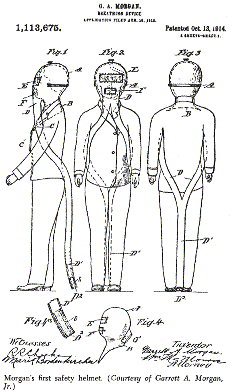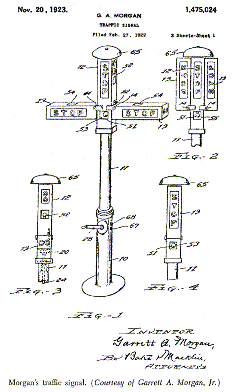Garrett Morgan
Today, thoughts about traffic lights, gas masks, and hair straighteners. The University of Houston's College of Engineering presents this series about the machines that make our civilization run, and the people whose ingenuity created them.
In 1914, a New Orleans paper reported an advertising demonstration. First, an inky thick smoke had been created. Then an Indian assistant, Big Chief Mason, had donned the new Morgan safety hood and spent twenty minutes in the smoke without ill effect.
What the onlookers didn't know was that "Big Chief Mason" was, in fact, Garrett Augustus Morgan -- the safety hood's inventor. Morgan's mother was a freed slave; and, since his birth in 1877, American racism had steadily worsened. The only way he could sell the hood was to keep his black identity quiet. So he demonstrated it in a sort of cigar-store Indian disguise.
Fortune found Morgan out in 1916 while he was working in Cleveland. Workers were drilling a new tunnel under Lake Erie to supply fresh water. When they hit a pocket of natural gas, it exploded. Workers were trapped, suffocating in smoke and dust. Someone knew about Morgan's safety hood and called him in. He and his brother suited up and repeatedly went into the tunnel.
They saved two lives and recovered four bodies before officials closed the tunnel to rescue efforts. Unfortunately, Morgan's race was now exposed, and that hurt his sales. Still, the gas masks used in WW-I were derived from Morgan's safety hood.
That was only one Morgan invention. In 1923 he came up with the device that led to our three-way traffic lights. He saw that existing mechanical stop-and-go signals were dangerous, since they had no caution signal to buffer traffic flow. So he patented a three-armed signal. It indicated stop and go for traffic in two directions. It also had a four-way stop for pedestrians. And it had a signal for moving forward with caution -- the forerunner of today's yellow light. GE bought his patent for $40,000, which was a huge sum back then.
In his late years, Morgan was highly honored for his many contributions. By the age of thirty he'd set up a small sewing-machine shop where he patented sewing-machine improvements. Now sewing-machine needles functioned better when they were polished, and Morgan found, by chance, that commercial liquid polish would also straighten hair. He figured out how to make the stuff into a cream, created his own company, and marketed it.
When I was a child, many African-Americans straightened their hair so as to better blend into a white landscape. All of Morgan's other inventions saved lives and accommodated human need. And hair-straighteners met another kind of human need in 1910. Morgan did what he had to do in the worst of times.
And so it is no wonder that he dreamed of celebrating the hundredth anniversary of the Emancipation Proclamation on New Year's day, 1963. Garrett Morgan was still alive in 1963. But America's Emancipation Centennial in Chicago wasn't held until that August, and Morgan died one month before it actually took place.
I'm John Lienhard, at the University of Houston, where we're interested in the way inventive minds work.
(Theme music)
Hayden, R.C., Black American Inventors. Reading, MA: Addison Wesley Publishing Company, 1972.
This is a greatly revised version of Episode 146.
You will find a more up-to-date account of Garrett Morgan here.


Patent drawings for Morgan's gas mask on the left, and his traffic signal on the right.